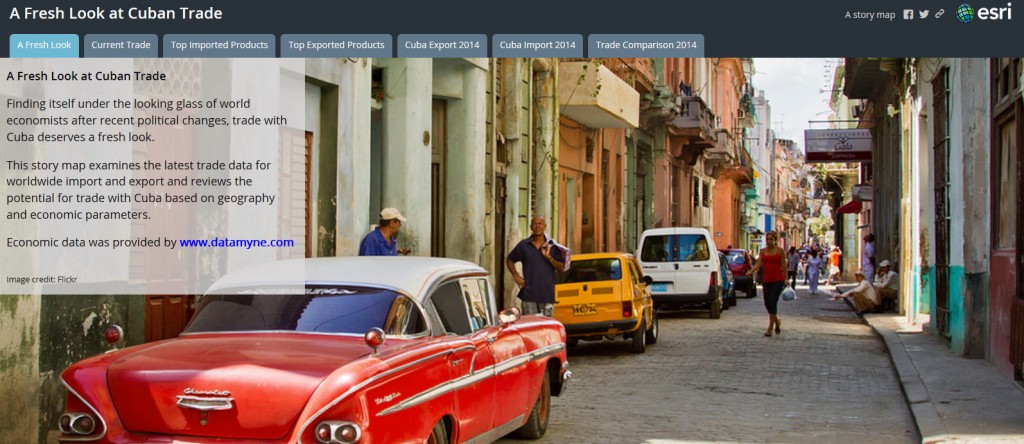A new story map lets us see what has happened in the past, and what might happen in the future, as the US trade embargo with Cuba is lifted.
Finding itself under the magnifying glass of world economists after recent political changes, trade with Cuba deserves a fresh look. Almost a year has passed since the United States and Cuba announced that diplomatic ties would be restored after nearly half a century of trade embargo between the two countries. There are some interesting opportunities for the US and implications for other nations too.
One change many economists expect is that US agricultural exports to Cuba will increase, driving economic growth and an appetite for higher-value commodities that will benefit both economies.
Let’s take a look at Cuba’s trade through the years and see if we can gain some insight into the future by looking at information from the past. Working with partner Datamyne, we created a new story map to easily view trade statistics.
The Current Situation
First, here’s the current trade situation in Cuba. Cuba’s economic strength has fluctuated over the last century. Once a flourishing economy in the mid-1900s, Cuba is now only ranked 80th in the world.

Products Imported into Cuba
Now that we know the value of trade between countries, let’s look a little closer at what Cuba imports. As a small nation with limited agricultural land to support its population, Cuba relies heavily on imports from other countries. The top 10 import partners are shown with the most important product for each country.

Wait—doesn’t the United States have a trade embargo in place with Cuba? Then, why did the United States supply not only chicken, but soybean oilcake, soybeans, corn, and animal feed to Cuba to the tune of $300 million in 2014? These goods are provided to Cuba under a special series of humanitarian exemptions for consumption by both humans and animals. At first glance this may seem like a large number, but in the context of total market share, US trade with Cuba represents only about 5 percent of a $6 billion trading market—despite being only 90 miles away.
If opportunities and regulations open up between Cuba and a geographically close trading heavy-weight like the United States, it very well may impact trade between Cuba and other countries. Could Canada and the US get into a kerfuffle over soybean exports? And how would this change the economy of Canada? Will the US consume all the cigars now going to Spain? Time will tell.
Top Exported Products from Cuba
What about exports from Cuba? Cuba exports a variety of products, from raw cane sugar to high-tech medical equipment. So, how do imports from Cuba’s top trading partners compare with exports from Cuba?

What does it all mean?
Cuba gives us some interesting insight into the economic state of the country based on trade patterns and partners. A country known for its austerity, Cuba is importing basic goods from trade partners such as China and India, instead of high-end goods like cars from Germany or fashion from Italy. What has happened? Cuba has found specific trade goods that can be produced at a volume and price that support Cuba’s unique economy.

Cuba also has a highly educated population and has made strong advances in medical and diagnostics. With the inability to cater to demand in the US market Cuba tightened its relationships with many Latin American countries. Today Latin America imports medical supplies and services at a competitive price from Cuba; products and services that compete successfully in quality and technology with other global suppliers.
From Austerity to Affordable Luxury?
The most interesting map will come in the near future, as the United States opens up its doors to import products and services sourced from Cuba as well as exports more freely into Cuba. The last two tabs in the story map show economic data for the last year. What do you think will be in Cuba’s future? Will traditional partners from colonial times such as Spain be challenged by the close proximity of the American market? Only time—and most likely a map—will tell.

